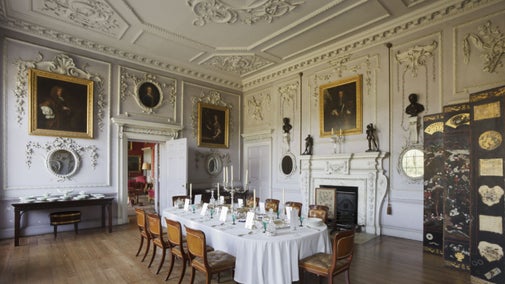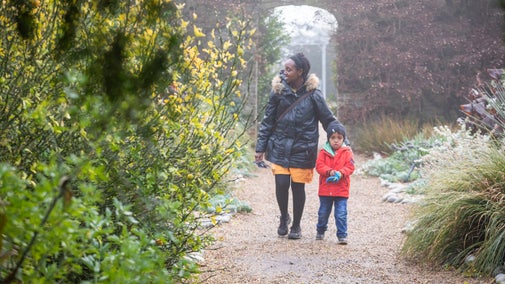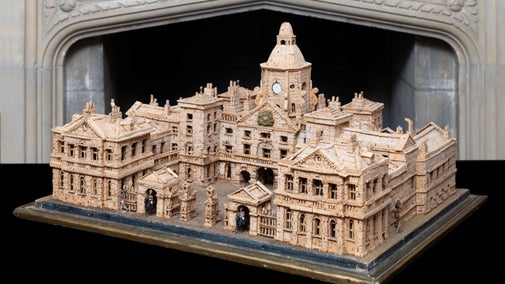
Felbrigg's collections
Explore the objects and works of art we care for at Felbrigg on the National Trust Collections website.

The last squire of Felbrigg, R.W. Ketton-Cramer, donated the estate, hall and, unusually, all of its contents to the National Trust in 1969. Today, Felbrigg Hall is home to one of the Trust’s largest collections.
Felbrigg’s collection of 160 architectural drawings is of national importance. The drawings were previously in too poor a condition for them to be used for interpretation or research, but have recently undergone a large-scale conservation project, generously part-funded by the National Manuscripts Conservation Trust and carried out by paper conservator Claire Gaskell.
Discover more about the architectural drawings
The wallpaper at Felbrigg is one of the most talked-about parts of the house by visitors, in particular that within the Chinese Bedroom. The Chinese wallpaper appears to have been supplied by the architect James Paine in 1751 and was hung by the paper-hanger John Scrutton in the spring of 1752.
From one of the earliest examples of block-printed and then hand-printed Chinese wallpaper in England, to wallpaper in the attics that may have led to the premature death of the sisters that lived here. Watch this short film and discover more about the designs that have inspired a new contemporary collection by Little Greene.
We ask for your permission before anything is loaded, as this content may introduce additional cookies. You may want to read the Google YouTube terms of service and privacy policy before accepting.
The marquetry technique perfected by master ébéniste (a cabinet maker) André-Charles Boulle in the 17th century inspired the most gifted cabinet makers of his time to embrace this remarkable craft - so much so that the process now bears his name.
There are five pieces of this historic furniture in the Felbrigg collection, which have recently gone through a three-year conservation project.
The Boulle furniture at Felbrigg
Felbrigg's collection contains a number of historic paintings, many of which are housed in the Cabinet Room. William Windham II remodelled what had previously been the Drawing Room as the setting for the Italian pictures acquired on his Grand Tour. These still hang very much as he originally planned.
Some of the rarest and most exceptional of the furnishings at Felbrigg were acquired by the landowner William Windham II (1717–1761). Upon inheriting the estate in 1749, he set about transforming the mansion according to the period’s ideals of modernity and elegance with the help of his architect, James Paine (1717–1789).
This was a moment when cosmopolitanism – an outward-looking curiosity about the world – was a sign of distinction that wealthy gentlemen sought to display in their houses. Italy, the Netherlands, France, but also East Asia and the Caribbean Islands, are evoked in his changes to Felbrigg. Originating in many different parts of the world, its contents are assembled with an eye for refinement, detail and luxury.
Yet such fine things were not to be had without a cost. As Britain grew more prosperous in the 18th century, so too did the demand for foreign goods that were secured by ever-more penetrating and extensive trading and colonial activities. An understanding of Felbrigg’s precious contents is incomplete without an understanding of the history of conflict, and sometimes violence, that made them available.
The works of art that Wyndham brought to Felbrigg demonstrate the sheer range of high-quality international goods available to the wealthy consumer in the middle of the eighteenth century. The rooms in which he lived announced a sophisticated taste that encompassed everything from Chinese wallpaper to Old Master paintings to tropical hardwoods.
But the elements of these cosmopolitan interiors were not obtained at an equal cost. While European works were obtained through the art market, East Asian goods came through trade routes that were secured through armed conflict and colonial expansion. Prized mahogany furniture was fashioned from timber felled by the enforced labour of enslaved, dislocated people in a land obtained through conquest.
Felbrigg is both a remarkable survival of 1750s luxury, and a precious insight into the complex, often painful, global situation that made it possible.

Explore the objects and works of art we care for at Felbrigg on the National Trust Collections website.
Discover more about the history of Felbrigg Hall in Norfolk, its past owners and how it came to be in the care of the National Trust.

Discover the hall at Felbrigg in Norfolk. A place of surprises and delights where each room stirs the imagination.

Discover the gardens at Felbrigg, including the widely renowned Walled Garden, bursting at the seams with heady colour, fragrance and textures.

Discover the important conservation work that takes place daily within the hall at Felbrigg, and look back at some of the important projects that have taken place in recent years.

The art and heritage collections we care for rival the world’s greatest museums. Learn more about the collection of paintings, decorative art, costume, books, household and other objects at historic places.

See the breadth of our collection of works of art, furniture and more: we care for around a million objects at over 200 historic places, there’s a surprise discovery around every corner.

Discover the stories behind some of the greatest artworks and artefacts looked after by the National Trust, as told in a dedicated book, 125 Treasures from the Collections of the National Trust.
